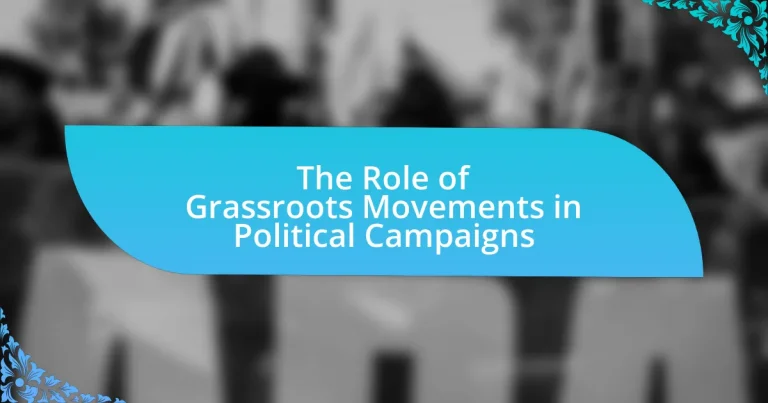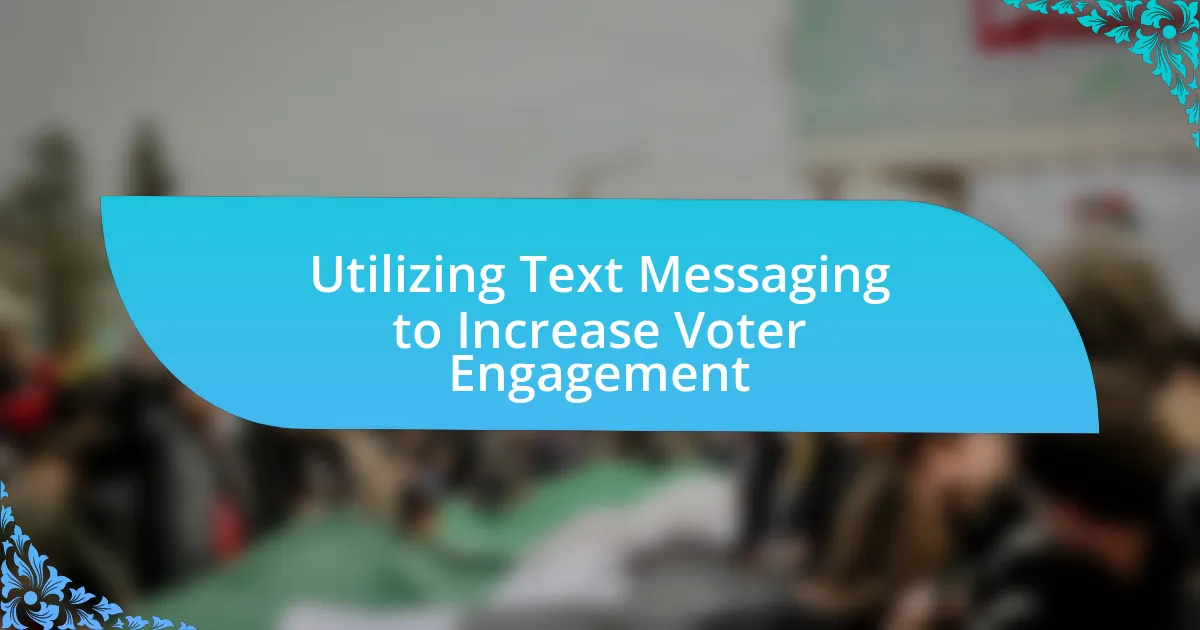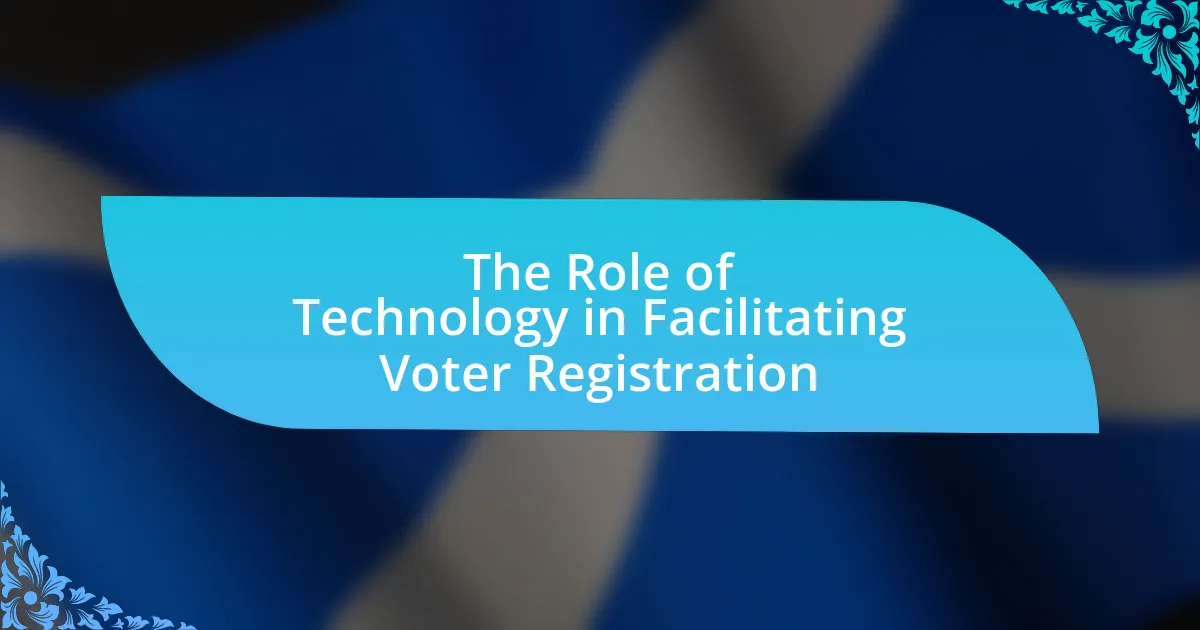Grassroots movements in political campaigns are organized efforts by ordinary citizens aimed at influencing political decisions and policies through community engagement and volunteer mobilization, rather than relying on large financial contributions. This article explores the characteristics, importance, and strategies of grassroots movements, highlighting their role in mobilizing voters and shaping political agendas. It also addresses the challenges these movements face, including limited resources and political opposition, while discussing future trends influenced by technology and social media. Key examples, such as the Black Lives Matter movement and the Women’s March, illustrate the significant impact grassroots activism can have on public policy and civic engagement.
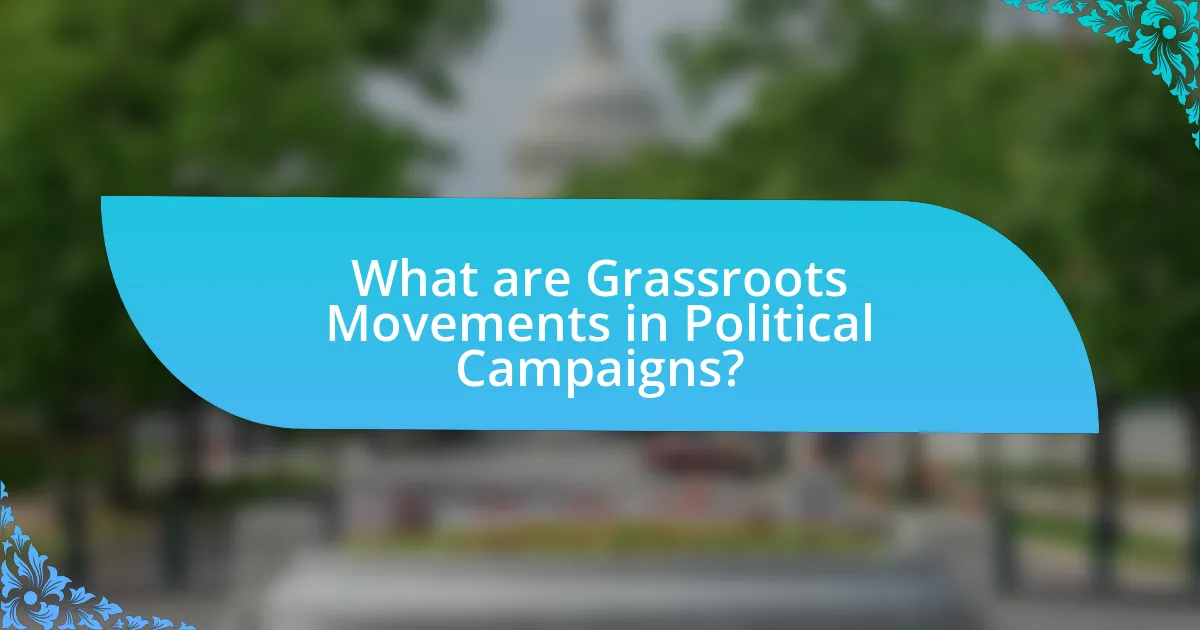
What are Grassroots Movements in Political Campaigns?
Grassroots movements in political campaigns are organized efforts by ordinary citizens to influence political decisions and policies at the local, state, or national level. These movements typically rely on community engagement, volunteer mobilization, and small donations rather than large financial contributions from corporations or political action committees. Historical examples include the Civil Rights Movement and the Tea Party, which demonstrated the power of grassroots organizing in shaping public discourse and policy outcomes. Research indicates that grassroots campaigns can significantly impact voter turnout and candidate success, as seen in the 2008 Obama campaign, which effectively utilized grassroots strategies to mobilize millions of supporters.
How do Grassroots Movements differ from traditional political campaigns?
Grassroots movements differ from traditional political campaigns primarily in their structure and funding sources. Grassroots movements are typically community-driven initiatives that rely on local volunteers and small donations, emphasizing collective action and direct engagement with constituents. In contrast, traditional political campaigns often depend on large financial contributions from wealthy donors and political action committees, focusing on top-down strategies and professional campaign staff. For example, the 2016 Bernie Sanders campaign exemplified a grassroots approach by raising over $230 million from small donations, while traditional campaigns like those of Hillary Clinton relied heavily on large donors and corporate funding. This fundamental difference in approach influences the level of community involvement and the types of issues prioritized in each model.
What are the key characteristics of Grassroots Movements?
Grassroots movements are characterized by their community-driven nature, emphasizing local participation and engagement. These movements typically arise from the collective efforts of individuals at the local level, seeking to address specific social, political, or environmental issues. They often rely on volunteer efforts and grassroots organizing strategies, such as door-to-door campaigning and community meetings, to mobilize support and raise awareness.
Additionally, grassroots movements prioritize inclusivity and democratic participation, allowing diverse voices to contribute to the movement’s goals. They frequently utilize social media and digital platforms to amplify their message and connect with a broader audience, as seen in movements like Black Lives Matter, which gained significant traction through online activism.
The effectiveness of grassroots movements is often evidenced by their ability to influence policy changes and mobilize large numbers of supporters, as demonstrated by the success of the Women’s March in 2017, which drew millions of participants worldwide to advocate for women’s rights and social justice.
Why are Grassroots Movements important in modern politics?
Grassroots movements are important in modern politics because they empower ordinary citizens to influence political change and policy decisions. These movements mobilize community members around shared interests or issues, fostering civic engagement and participation. For instance, the Black Lives Matter movement has significantly impacted discussions on racial justice and police reform, demonstrating how grassroots activism can shape national dialogue and policy. Additionally, grassroots movements often serve as a counterbalance to established political structures, providing a platform for marginalized voices and promoting democratic accountability. This dynamic is evident in the rise of movements like the Tea Party and Occupy Wall Street, which have reshaped political landscapes by highlighting specific grievances and mobilizing large segments of the population.
What role do Grassroots Movements play in mobilizing voters?
Grassroots movements play a crucial role in mobilizing voters by fostering community engagement and encouraging participation in the electoral process. These movements often utilize local networks to raise awareness about issues, organize events, and facilitate voter registration drives. For instance, the 2018 midterm elections in the United States saw a significant increase in voter turnout, largely attributed to grassroots organizations like Indivisible and MoveOn, which effectively mobilized communities around key issues such as healthcare and immigration. Their efforts resulted in a 50% increase in voter turnout among young voters compared to previous elections, demonstrating the tangible impact grassroots movements have on voter mobilization.
How do Grassroots Movements engage local communities?
Grassroots movements engage local communities by fostering direct participation and empowering individuals to take collective action on issues that affect them. These movements often utilize community organizing techniques, such as town hall meetings, workshops, and social media campaigns, to raise awareness and mobilize residents. For instance, the Black Lives Matter movement effectively engaged local communities through protests and educational events, which highlighted systemic racism and encouraged civic involvement. This approach not only builds a sense of community but also enhances political awareness and advocacy, leading to increased voter turnout and local activism.
What strategies do Grassroots Movements use to increase voter turnout?
Grassroots movements use community engagement, targeted outreach, and mobilization strategies to increase voter turnout. These movements often organize local events, such as town halls and rallies, to foster a sense of community and encourage participation. They utilize social media platforms to reach younger voters and disseminate information about voting procedures, deadlines, and the importance of civic engagement. Research indicates that grassroots efforts can significantly impact voter turnout; for example, a study by the National Bureau of Economic Research found that door-to-door canvassing increased turnout by 7% in targeted neighborhoods. Additionally, grassroots movements often collaborate with local organizations to identify and address barriers to voting, ensuring that marginalized communities have access to the polls.
How do Grassroots Movements influence political agendas?
Grassroots movements influence political agendas by mobilizing community members to advocate for specific issues, thereby shaping public discourse and policy priorities. These movements often utilize social media and local organizing to raise awareness and build coalitions, which can lead to significant political pressure on elected officials. For example, the Black Lives Matter movement has successfully brought issues of racial justice and police reform to the forefront of national political discussions, resulting in legislative proposals and changes in law enforcement practices in various jurisdictions. This demonstrates how grassroots activism can directly impact the political landscape by aligning public sentiment with policy initiatives.
What issues are commonly championed by Grassroots Movements?
Grassroots movements commonly champion issues such as social justice, environmental protection, healthcare reform, and economic equality. These movements often arise from local communities advocating for change, driven by the need to address systemic inequalities and injustices. For instance, the Black Lives Matter movement focuses on racial equality and police reform, while climate activism, exemplified by movements like Fridays for Future, emphasizes urgent action against climate change. Additionally, grassroots efforts for universal healthcare, such as those promoted by organizations like Healthcare-NOW!, highlight the demand for accessible medical services. Economic equality is also a significant focus, with movements advocating for living wages and workers’ rights, as seen in the Fight for $15 campaign.
How do Grassroots Movements shape public policy discussions?
Grassroots movements shape public policy discussions by mobilizing community members to advocate for specific issues, thereby influencing policymakers and public opinion. These movements often utilize social media and local organizing to raise awareness and create a sense of urgency around their causes, which can lead to increased visibility and pressure on government officials. For example, the Black Lives Matter movement has significantly impacted discussions on police reform and racial justice, leading to legislative proposals and changes in law enforcement practices across various states. This demonstrates how grassroots activism can translate community concerns into actionable policy debates, ultimately shaping the legislative agenda.

What are the challenges faced by Grassroots Movements in Political Campaigns?
Grassroots movements in political campaigns face several significant challenges, including limited funding, lack of media coverage, and organizational difficulties. Limited funding restricts their ability to reach wider audiences and compete with well-funded opponents, as evidenced by the fact that many grassroots campaigns operate on minimal budgets compared to traditional political campaigns that can spend millions. Lack of media coverage often leads to reduced visibility and public awareness, making it difficult for these movements to gain traction; studies show that mainstream media tends to favor established candidates over grassroots initiatives. Additionally, organizational difficulties arise from the need to mobilize volunteers and coordinate efforts effectively, which can be hampered by a lack of experience and resources. These challenges collectively hinder the effectiveness and impact of grassroots movements in the political arena.
What obstacles do Grassroots Movements encounter in fundraising?
Grassroots movements encounter several obstacles in fundraising, primarily including limited access to traditional funding sources, lack of established networks, and regulatory challenges. Limited access to traditional funding sources arises because grassroots movements often lack connections to wealthy donors or institutional funding, which can restrict their financial support. Additionally, the absence of established networks makes it difficult for these movements to reach potential supporters and mobilize resources effectively. Regulatory challenges, such as compliance with campaign finance laws, can further complicate fundraising efforts, as grassroots organizations may struggle to navigate complex legal requirements. These factors collectively hinder the ability of grassroots movements to secure necessary funding for their initiatives.
How do limited resources impact the effectiveness of Grassroots Movements?
Limited resources significantly hinder the effectiveness of grassroots movements by restricting their ability to mobilize supporters, communicate messages, and sustain activities. For instance, a lack of funding can lead to inadequate outreach efforts, limiting the movement’s visibility and engagement with potential allies. Research indicates that grassroots campaigns with fewer financial resources often struggle to compete against well-funded opponents, as seen in the 2016 U.S. presidential election where candidates with substantial campaign financing dominated media coverage and public attention. Additionally, limited resources can result in fewer volunteers and reduced organizational capacity, which directly impacts the movement’s ability to execute strategic initiatives and respond to challenges effectively.
What strategies can Grassroots Movements employ to overcome fundraising challenges?
Grassroots movements can employ several strategies to overcome fundraising challenges, including leveraging social media for outreach, building community partnerships, and hosting local events. By utilizing social media platforms, grassroots movements can reach a wider audience at a lower cost, allowing them to engage potential donors effectively. For instance, campaigns that use targeted ads on platforms like Facebook have seen increased donations, as these ads can be tailored to specific demographics.
Additionally, forming partnerships with local businesses and organizations can provide mutual benefits, such as shared resources and increased visibility, which can enhance fundraising efforts. Research indicates that collaborations can lead to a 30% increase in fundraising success for community-based initiatives.
Hosting local events, such as fundraisers or awareness campaigns, can also create a sense of community involvement and encourage donations. Events that engage participants often result in higher contributions, as they foster a personal connection to the cause. According to a study by the Nonprofit Finance Fund, organizations that actively engage their communities through events see a 50% higher rate of repeat donations.
How do Grassroots Movements navigate political opposition?
Grassroots movements navigate political opposition by employing strategic coalition-building, grassroots mobilization, and effective communication. These movements often form alliances with like-minded organizations to amplify their voice and increase their influence, as seen in the Civil Rights Movement, where coalitions with churches and labor unions strengthened their efforts against systemic racism. Additionally, grassroots movements mobilize community members to participate in protests, advocacy, and voter registration drives, which can shift public opinion and apply pressure on political leaders. Effective communication strategies, including social media campaigns, allow these movements to disseminate their messages widely and counteract opposition narratives. For instance, the Women’s March utilized social media to organize and galvanize support, demonstrating the power of communication in overcoming political barriers.
What tactics are used to counteract negative campaigning?
Tactics used to counteract negative campaigning include promoting positive messaging, fact-checking, and engaging grassroots support. Positive messaging focuses on highlighting the candidate’s strengths and achievements, which can overshadow negative attacks. Fact-checking involves quickly addressing false claims made in negative ads, thereby restoring credibility and trust. Engaging grassroots support mobilizes volunteers and community members to spread positive narratives and counter misinformation, effectively creating a more favorable public perception. These tactics have been shown to mitigate the impact of negative campaigning, as evidenced by studies indicating that campaigns emphasizing positive outreach can improve voter sentiment and turnout.
How can Grassroots Movements build coalitions to strengthen their position?
Grassroots movements can build coalitions to strengthen their position by identifying shared goals and values with other organizations and communities. By collaborating with like-minded groups, grassroots movements can pool resources, share expertise, and amplify their collective voice, which enhances their influence in political campaigns. For instance, the Women’s March in 2017 successfully united various organizations advocating for women’s rights, racial equality, and LGBTQ+ rights, demonstrating how diverse groups can come together for a common cause. This coalition-building not only increases visibility but also fosters solidarity, making it more challenging for policymakers to ignore their demands.
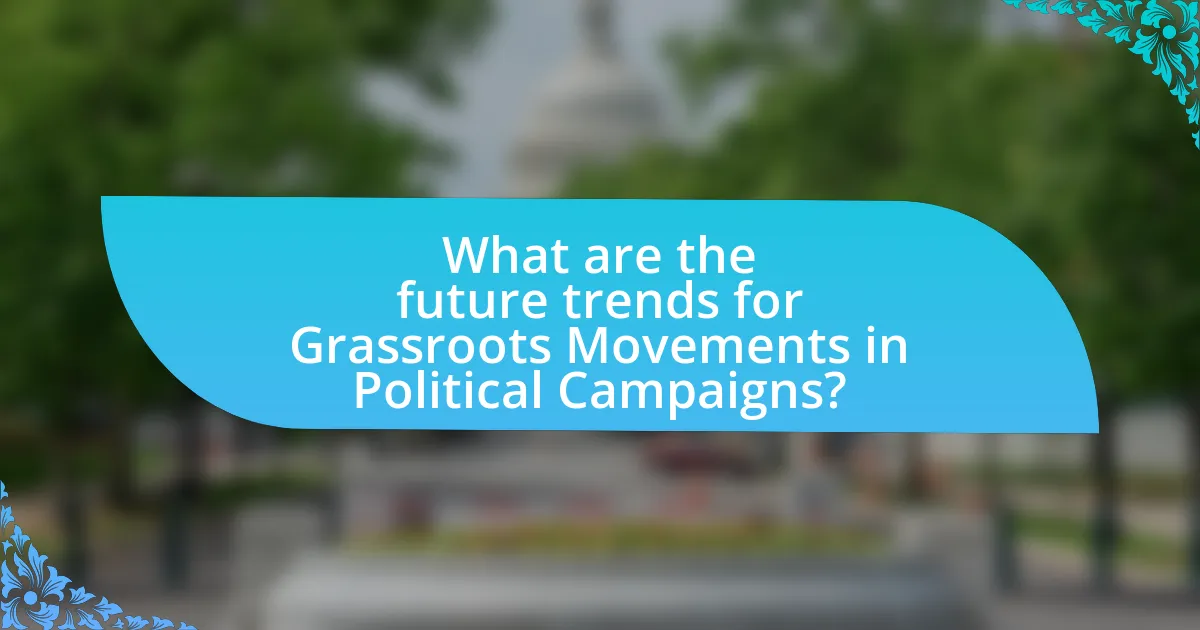
What are the future trends for Grassroots Movements in Political Campaigns?
Future trends for grassroots movements in political campaigns include increased reliance on digital platforms, enhanced community engagement, and a focus on intersectionality. Digital platforms enable grassroots organizations to mobilize supporters quickly and efficiently, as seen in recent campaigns where social media has played a pivotal role in outreach and fundraising. Enhanced community engagement is evident through localized efforts that prioritize direct voter contact and grassroots organizing, which have proven effective in recent elections. Additionally, a focus on intersectionality allows movements to address multiple social justice issues simultaneously, appealing to a broader base and fostering coalition-building among diverse groups. These trends reflect a shift towards more inclusive and technology-driven approaches in political campaigning.
How is technology changing the landscape for Grassroots Movements?
Technology is transforming grassroots movements by enhancing communication, mobilization, and fundraising capabilities. Social media platforms enable rapid dissemination of information, allowing grassroots organizations to reach wider audiences and engage supporters in real-time. For instance, the #BlackLivesMatter movement utilized Twitter and Facebook to organize protests and share resources, significantly amplifying its impact. Additionally, crowdfunding platforms like GoFundMe have revolutionized fundraising, enabling grassroots movements to secure financial support directly from their communities. According to a 2020 report by the Pew Research Center, 69% of Americans believe social media is an effective tool for political activism, highlighting its role in shaping public discourse and mobilizing grassroots efforts.
What role do social media platforms play in Grassroots organizing?
Social media platforms play a crucial role in grassroots organizing by facilitating communication, mobilization, and community building among activists. These platforms enable grassroots movements to reach a wider audience quickly, allowing for the rapid dissemination of information and calls to action. For instance, the Black Lives Matter movement effectively utilized Twitter and Facebook to organize protests and share resources, demonstrating the power of social media in amplifying grassroots efforts. Additionally, studies show that social media engagement can significantly increase participation in events, with a 2018 Pew Research Center report indicating that 69% of adults in the U.S. use social media, making it an essential tool for grassroots organizers to connect with potential supporters and foster collective action.
How can data analytics enhance the effectiveness of Grassroots Movements?
Data analytics can enhance the effectiveness of grassroots movements by enabling targeted outreach and resource allocation. By analyzing demographic data, social media engagement, and community needs, grassroots organizations can identify key supporters and tailor their messaging to resonate with specific audiences. For instance, a study by the Pew Research Center found that data-driven campaigns can increase voter turnout by up to 20% when messages are personalized based on voter preferences and behaviors. This targeted approach not only maximizes the impact of limited resources but also fosters stronger community connections, ultimately leading to more successful advocacy efforts.
What best practices can Grassroots Movements adopt for success?
Grassroots movements can adopt several best practices for success, including building a strong community base, leveraging social media for outreach, and fostering inclusive participation. A strong community base ensures that the movement has local support and resources, which is critical for mobilization and sustainability. For instance, the Black Lives Matter movement effectively utilized community organizing to create a network of local chapters that engage with their specific communities. Leveraging social media allows grassroots movements to reach a wider audience quickly and efficiently; for example, the Ice Bucket Challenge raised over $115 million for ALS research in just a few months through viral social media engagement. Lastly, fostering inclusive participation ensures diverse voices are heard, which strengthens the movement’s legitimacy and appeal; research shows that inclusive movements are more likely to achieve their goals, as seen in the Women’s March, which brought together millions from various backgrounds to advocate for women’s rights.
How can Grassroots Movements effectively communicate their message?
Grassroots movements can effectively communicate their message by utilizing social media platforms to reach a wider audience and engage directly with community members. Research indicates that social media allows grassroots organizations to disseminate information rapidly, mobilize supporters, and create a sense of community around shared goals. For instance, during the 2011 Occupy Wall Street movement, social media played a crucial role in organizing protests and spreading awareness about economic inequality, demonstrating its effectiveness in grassroots communication.
What are the key elements of a successful Grassroots campaign strategy?
A successful grassroots campaign strategy includes community engagement, clear messaging, and mobilization of volunteers. Community engagement fosters relationships and builds trust, which is essential for rallying support. Clear messaging ensures that the campaign’s goals resonate with the target audience, making it easier to communicate the campaign’s purpose and values. Mobilization of volunteers is critical, as it leverages local networks to amplify the campaign’s reach and effectiveness. According to a study by the Pew Research Center, campaigns that effectively engage their communities and utilize volunteers see a 30% increase in voter turnout compared to those that do not.












